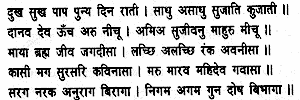| |


Though born together in the world, their qualities are different like the lotus and leech. The good and the bad thus resemble nectar and intoxicating drink; the deep ocean in the form of this world is their common parent.

The good and the bad, according to their deeds, gather a rich harvest of honour and dishonour; the good are like nectar or the moon or Ganga, the harmful like poison or fire or the river Karmanasha. Their merits and demerits are known to all; but whatever is to a manís taste seems good to him.

The good aim at goodness and the vile at vileness; nectar is praised for giving immortality, and for its deadly effects.

The tales of sins and vices of the wicked and of the virtues of the good are like the boundless, unfathomable ocean, so only a few virtues and vices have been mentioned, for unless they are recognized, one cannot accumulate the former or shun the latter.

It is God who has created all the good and the bad, but it is the Vedas that with careful discrimination have distinguished one from the other. The heroic legends and the Puranas also, no less than the Vedas, declare that Godís creation is a mixture of virtue and vice.

It is characterized by pairs of opposites such as pain and pleasure, sin and merit, day and night, saint and sinner, high caste and low, demons and gods, the lofty and the base, nectar and poison, a happy life and death, the world of illusion and the Absolute, the individual soul and God, wealth and poverty, the beggar and the king, Kashi and Magadh, Ganga and Karmanasha, marwar and Malwa, the Brahman and the butcher, heaven and hell, attachment and dispassion Ė the Vedas and the Agamas have made distinction of every variety of good and evil.

God has created the universe consisting of things animate and inanimate and endowed it with virtues and defects, the saint like a swan extracts the milk of goodness and rejects the worthiness water.
|
|
